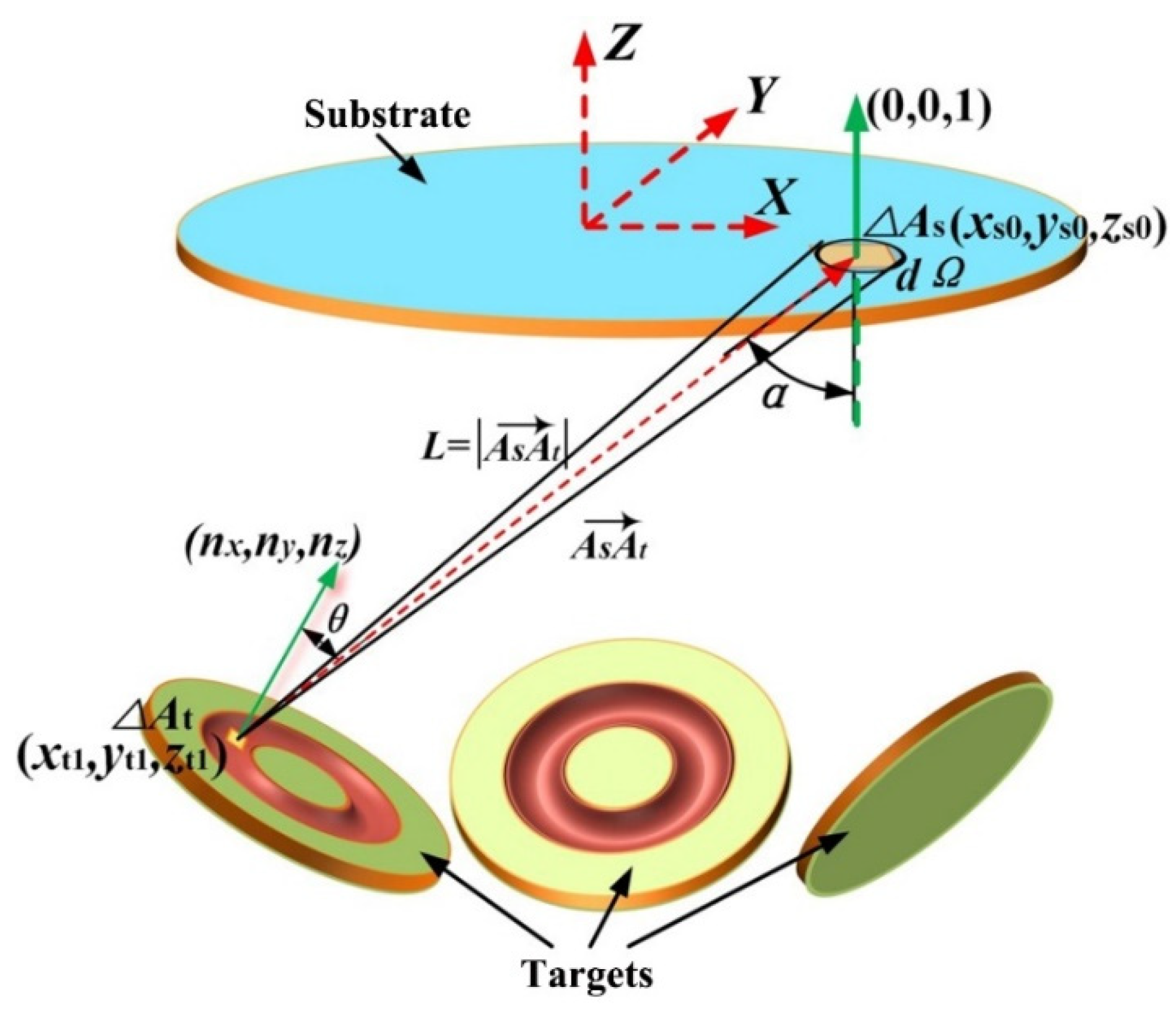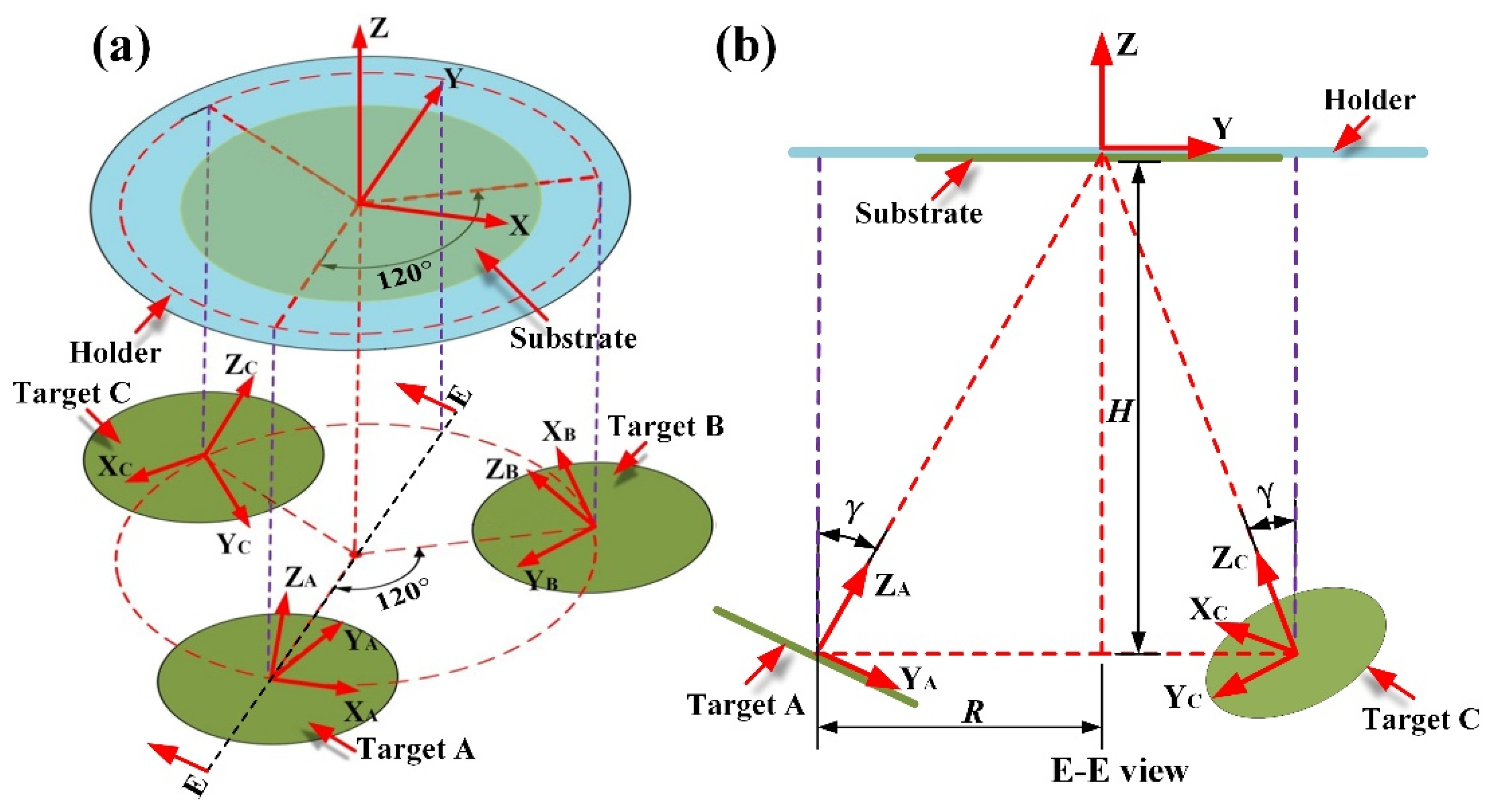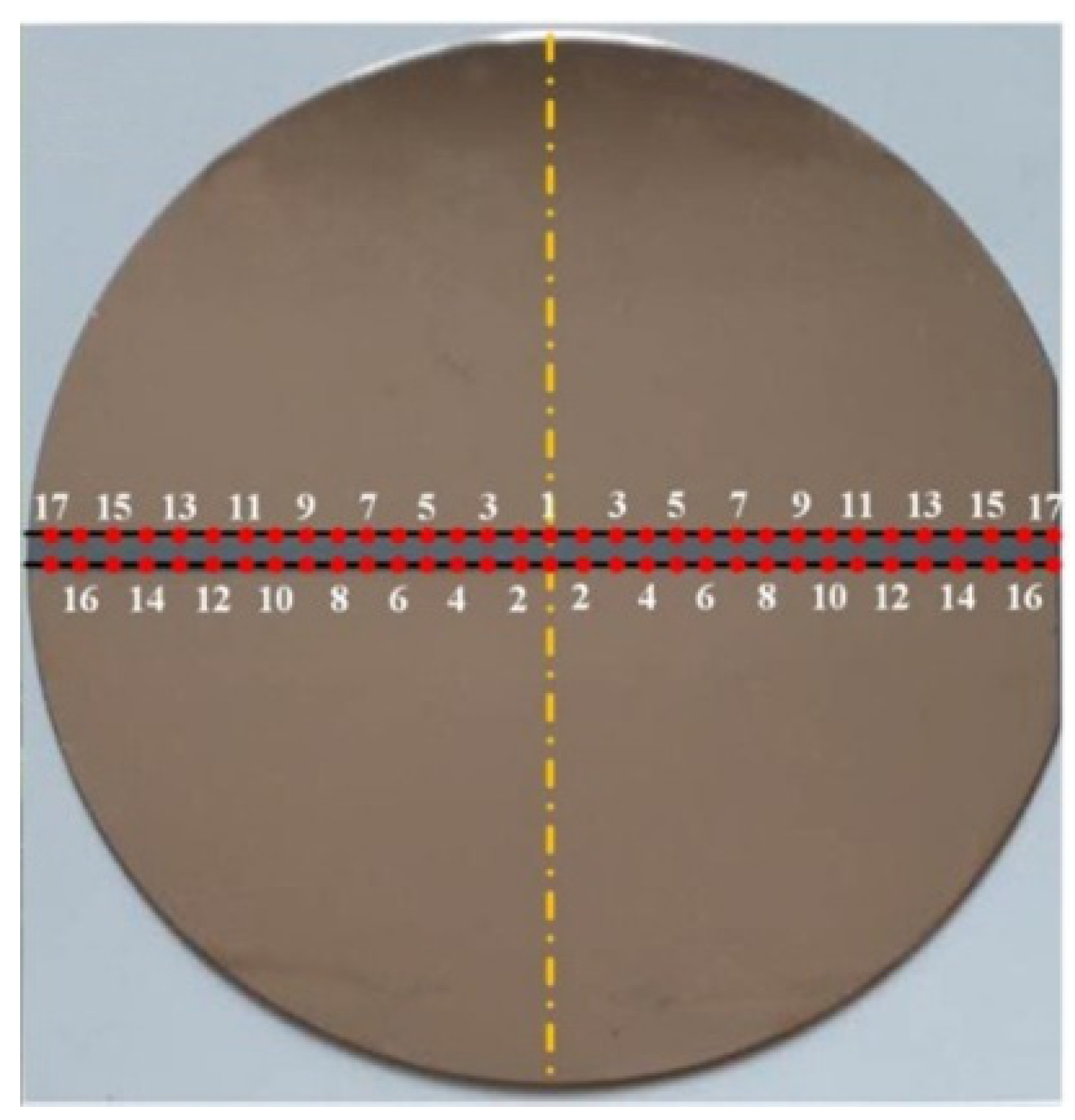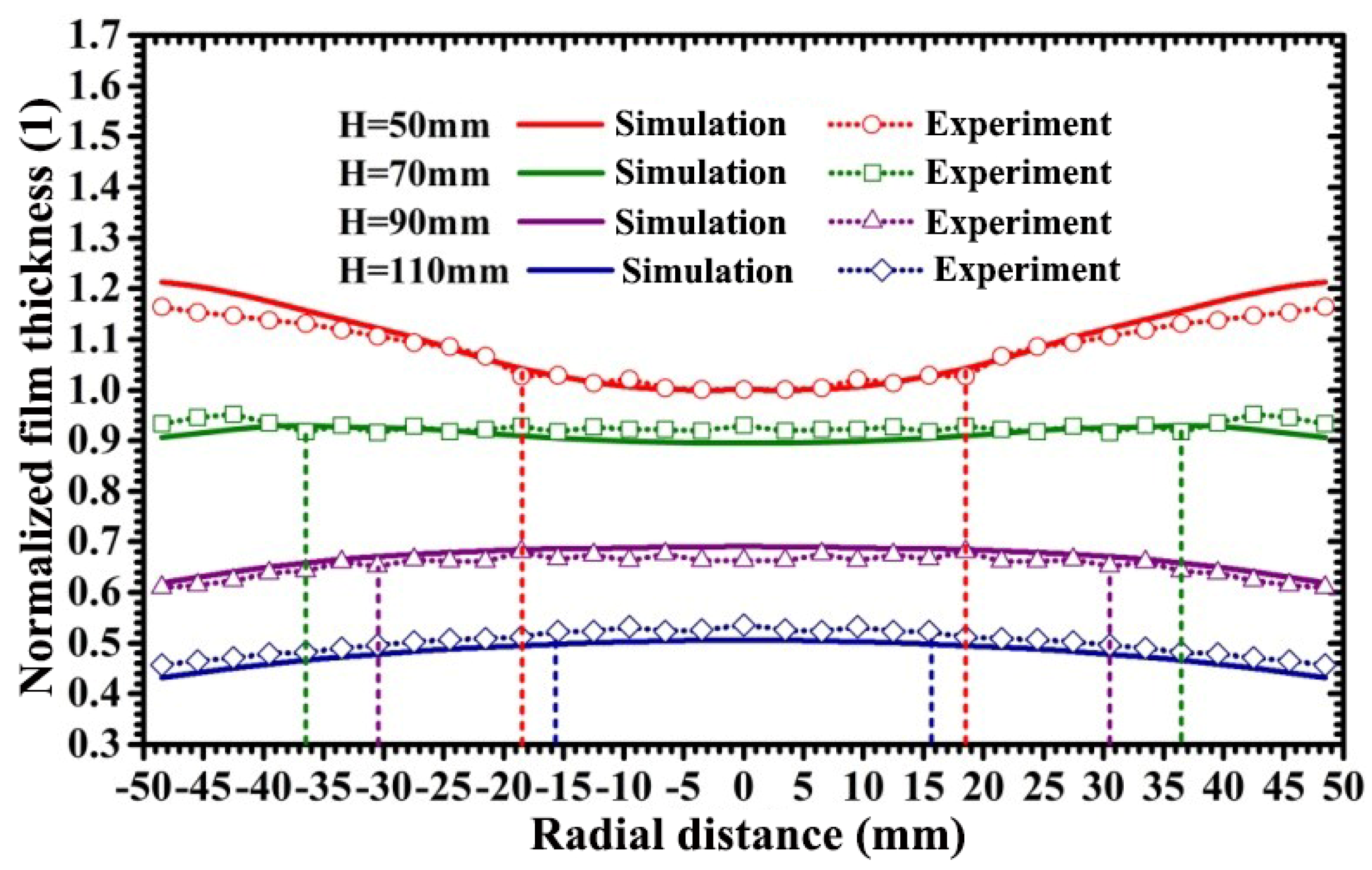Study on the Deposition Uniformity of Triple-Target Magnetron Co-Sputtering System: Numerical Simulation and Experiment
Abstract
:1. Introduction
2. Model and Method
2.1. Analytical Model
- The sputtering rate distribution of the target material, which is dependent on both the horizontal and vertical magnetic field intensities on the target surface, can be described as below [22]:where Br(xt,yt) and Bz(xt,yt) represent the horizontal and vertical magnetic field intensities on the target surface, respectively.
- The deposition rate of sputtered particles onto a substrate surface has a negative exponent relationship with path length L [24]:where λm is the mean free path of the sputtered particle, kB is the Boltzmann constant, σ is the cross-section for momentum transfer, and Tg and P are the temperature and pressure of the background gas, respectively.
- Sputtered particles are immediately condensed when they arrive at the substrate.
2.2. Global Coordinates of the Infinitesimal Elements on Substrate and Three Targets
3. Experiment
4. Results and Discussion
4.1. Effect of Target-Substrate Angle on Film Thickness Distribution
4.2. Effect of Target-Substrate Distance on Film Thickness Distribution
5. Discussion
6. Conclusions
Author Contributions
Funding
Institutional Review Board Statement
Informed Consent Statement
Data Availability Statement
Conflicts of Interest
References
- Mazur, M.; Obstarczyk, A.; Posadowski, W.; Domaradzki, J.; Kiełczawa, S.; Wiatrowski, A.; Wojcieszak, D.; Kalisz, M.; Grobelny, M.; Szmidt, J. Investigation of the Microstructure, Optical, Electrical and Nanomechanical Properties of ZnOx Thin Films Deposited by Magnetron Sputtering. Materials 2022, 15, 6551. [Google Scholar] [CrossRef]
- Bernal-Salamanca, M.; Balcells, L.; Konstantinovi´c, Z.; Pomar, A.; Martínez, B.; Frontera, C. Optimization of the Growth Process of Double Perovskite Pr2−δNi1−xMn1+xO6−y Epitaxial Thin Films by RF Sputtering. Materials 2022, 15, 5046. [Google Scholar] [CrossRef] [PubMed]
- Luna-Moreno, D.; Monzón-Hernández, D. Effect of the Pd–Au thin film thickness uniformity on the performance of an optical fiber hydrogen sensor. Appl. Surf. Sci. 2007, 253, 8615–8619. [Google Scholar] [CrossRef]
- Lenis, J.A.; Gómez, M.A.; Bolívar, F.J. Effect of deposition temperature and target-substrate distance on the structure, phases, mechanical and tribological properties of multi-layer HA-Ag coatings obtained by RF magnetron sputtering. Surf. Coat. Technol. 2019, 378, 124936. [Google Scholar] [CrossRef]
- Shishkov, M.; Popov, D. Thickness uniformity of thin films deposited on a flat substrate by sputtering of a target with rotational symmetry. Vacuum 1991, 42, 1005–1008. [Google Scholar] [CrossRef]
- Ekpe, S.D.; Bezuidenhout, L.W.; Dew, S.K. Deposition rate model of magnetron sputtered particles. Thin Solid Films 2005, 474, 330–336. [Google Scholar] [CrossRef]
- Zhang, Y.C.; Song, Q.; Sun, Z. Research on thin film thickness uniformity for deposition of rectangular planar sputtering target. Phys. Procedia 2012, 32, 903–913. [Google Scholar] [CrossRef] [Green Version]
- Du, X.S.; Jiang, Y.D.; Yu, J.S.; Li, J.; Xie, G.Z. Quantitative evaluation of film thickness uniformity: Application to off-axis magnetron source onto a rotating substrate. J. Vac. Sci. Technol. A 2007, 25, 215–220. [Google Scholar] [CrossRef]
- Fujimoto, T.; Li, B.; Kojima, I.; Yokoyama, S.I.; Murakami, S.I. An ultrahigh vacuum sputtering system with offset incidence magnetron sources onto a rotating substrate. Rev. Sci. Instrum. 1999, 70, 4362–4365. [Google Scholar] [CrossRef]
- Fu, C.; Yang, C.; Han, L.; Chen, H. The thickness uniformity of films deposited by magnetron sputtering with rotation and revolution. Surf. Coat. Technol. 2006, 200, 3687–3689. [Google Scholar] [CrossRef]
- Yang, Z.; Yang, L.; Dai, B.; Huang, X.; Wang, Q.; Zhang, Y.; Han, J.; Zhu, J. Uniform films deposited on convex surfaces by magnetron sputtering with a small target. Thin Solid Films 2018, 665, 1–5. [Google Scholar] [CrossRef]
- Vasilev, D.D.; Moiseev, K.M. Influence of the planar cylindrical target erosion zone of magnetron sputtering on the uniformity of a thin-film coating. J. Phys. Conf. Ser. 2015, 584, 012012. [Google Scholar] [CrossRef] [Green Version]
- Li, C.; Song, S.; Waddell, E.; Child, D.; Gibson, D. Modelling and Validation of a Large Area Thin Film Uniform Deposition on a Rotating Drum Using Microwave Reactive Sputtering. Opt. Interf. Coat. 2016, 65, C65–C70. [Google Scholar] [CrossRef]
- Fukami, T.; Shintani, F.; Naoe, M. Observations on the operation of a planar magnetron sputtering system by target erosion patterns. Thin Solid Films 1987, 151, 373–381. [Google Scholar] [CrossRef]
- Spencer, A.G.; Bishop, C.A.; Howson, R.P. The design and performance of planar magnetron sputtering cathodes. Vacuum 1987, 37, 363–366. [Google Scholar] [CrossRef]
- Perlov, C.; Brauer, J. Computer-aided design of a magnetron sputtering cathode. IEEE Trans. Magn. 1986, 22, 831–833. [Google Scholar] [CrossRef]
- Wong, M.S.; Sproul, W.D.; Rohde, S.L. Modeling magnetic fields of magnetron sputtering systems. Surf. Coat. Technol. 1991, 49, 121–126. [Google Scholar] [CrossRef]
- Fan, Q.H.; Chen, H.Y. Effects of magnetic field on the target erosion in the symmetrical magnets magnetron sputtering method. Thin Solid Films 1993, 229, 143–145. [Google Scholar] [CrossRef]
- Reicher, D.W.; Christian, R.; Davidson, P.; Peplinski, S.Z. Use of multiple DC magnetron deposition sources for uniform coating of large areas. Proc. Spie 2009, 7409, 740909. [Google Scholar] [CrossRef]
- Tian, G.; Shi, T.; Li, X.; Lu, X.; Wang, Y.; Liu, C. Low resistivity and near-zero temperature drift ZrB2-Ag composite films prepared by DC magnetron co-sputtering. Mater. Lett. 2022, 307, 130992. [Google Scholar] [CrossRef]
- Zhang, S.W.; Hou, L.Y.; Han, Y.C.; Xie, Y.H. A Calculation Model for the Film Thickness and Component Uniformity of Twin Co-Sputtering Target System. Adv. Mater. Res. 2010, 129, 218–223. [Google Scholar] [CrossRef]
- Golosov DA, E.; Melnikov, S.N.; Kundas, S.P.; Dostanko, A. Prediction of targets erosion in magnetron sputtering systems. Prob. Fiz. Mat. Tekh. 2010, 2, 62–67. Available online: http://mi.mathnet.ru/eng/pfmt/y2010/i2/p62 (accessed on 12 May 2021).
- Yamamura, Y.; Takiguchi, T.; Ishida, M. Energy and angular distributions of sputtered atoms at normal incidence. Radiat. Eff. Defect. S. 1991, 118, 237–261. [Google Scholar] [CrossRef]
- Petrov, I.; Ivanov, I.; Orlinov, V.; Sundgren, J.E. Comparison of magnetron sputter deposition conditions in neon, argon, krypton, and xenon discharges. J. Vac. Sci. Technol. A. 1993, 11, 2733–2741. [Google Scholar] [CrossRef]
- Chan, K.Y.; Luo, P.Q.; Zhou, Z.B.; Tou, T.Y.; Teo, B.S. Influence of direct current plasma magnetron sputtering parameters on the material characteristics of polycrystalline copper films. Appl. Surf. Sci. 2009, 255, 5186–5190. [Google Scholar] [CrossRef]
- Jiang, C.Z.; Zhu, J.Q.; Han, J.C.; Lei, P.; Yin, X.B. Uniform film in large areas deposited by magnetron sputtering with a small target. Surf. Coat. Technol. 2013, 229, 222–225. [Google Scholar] [CrossRef]
- Santos, J.P.E. Measuring the magnetic field distribution of a magnetron sputtering target. J. Vac. Sci. Technol. A. 1999, 17, 3118–3120. [Google Scholar] [CrossRef]
- Mahieu, S.; Buyle, G.; Depla, D.; Heirwegh, S.; Ghekiere, P.; Gryse, R.D. Monte Carlo simulation of the transport of atoms in DC magnetron sputtering. Nucl. Instrum. Meth. B 2006, 243, 313–319. [Google Scholar] [CrossRef]
- Zhu, G.; Sun, J.; Gan, Z.Y. A Novel Approach to Calculate the Deposition Uniformity of Multi-Target Sputtering System. In Proceedings of the 19th International Conference on Electronic Packaging Technology (ICEPT), Shanghai, China, 8–11 August 2018. [Google Scholar]









Publisher’s Note: MDPI stays neutral with regard to jurisdictional claims in published maps and institutional affiliations. |
© 2022 by the authors. Licensee MDPI, Basel, Switzerland. This article is an open access article distributed under the terms and conditions of the Creative Commons Attribution (CC BY) license (https://creativecommons.org/licenses/by/4.0/).
Share and Cite
Zhu, G.; Xiao, B.; Chen, G.; Gan, Z. Study on the Deposition Uniformity of Triple-Target Magnetron Co-Sputtering System: Numerical Simulation and Experiment. Materials 2022, 15, 7770. https://doi.org/10.3390/ma15217770
Zhu G, Xiao B, Chen G, Gan Z. Study on the Deposition Uniformity of Triple-Target Magnetron Co-Sputtering System: Numerical Simulation and Experiment. Materials. 2022; 15(21):7770. https://doi.org/10.3390/ma15217770
Chicago/Turabian StyleZhu, Guo, Baijun Xiao, Ganxin Chen, and Zhiyin Gan. 2022. "Study on the Deposition Uniformity of Triple-Target Magnetron Co-Sputtering System: Numerical Simulation and Experiment" Materials 15, no. 21: 7770. https://doi.org/10.3390/ma15217770
APA StyleZhu, G., Xiao, B., Chen, G., & Gan, Z. (2022). Study on the Deposition Uniformity of Triple-Target Magnetron Co-Sputtering System: Numerical Simulation and Experiment. Materials, 15(21), 7770. https://doi.org/10.3390/ma15217770







